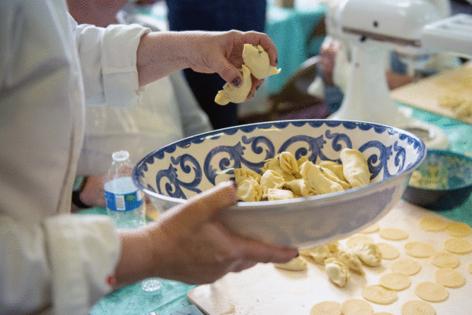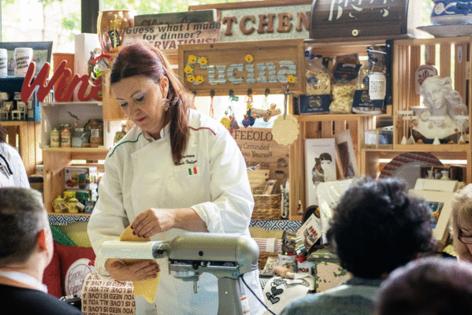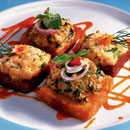Make Italian pasta with a pro when you knead to get over this phobia
Published in Variety Menu
PITTSBURGH — Despite being a food reporter, I am by no means a master chef. I can handle simple recipe instructions like "stir," "fry," "simmer," "bake" or, maybe, "braise" — which is basically a combination of simmer and bake. I have an irrational fear of anything that requires equipment beyond a pot or pan.
Full of hope, my family once bought me "Le Larousse des Desserts" by the French macaron genius Pierre Hermé (a beautiful book, by the way), and I don't think I've made even one thing from its pages. I have admired the photos, though. (Careful piping is involved in making macarons, among other techniques.)
My apparatus-phobia might explain why I've never attempted to make homemade pasta, even though you need only two or three ingredients to make the dough. A friend of mine, when I was living in Philly and we both had houses near the Italian Market, used to demonstrate how simple it is, mixing the dough with his fingers and rolling it out with a machine.
But there you go. I would need some sort of special rolling thingy. No way.
On a recent Sunday, however, Viviana Altieri opened my eyes.
A proud Roman native, Altieri founded Istituto Mondo Italiano in 2003. Located in Regent Square, the Istituto functions as a center for Italian language and culture in Pittsburgh. On weekends, Altieri often teaches hands-on cooking classes.
Among her course offerings is a series on "Pasta from the Past," during which she highlights a rotating roster of traditional pastas from regions of Italy. Crucially for me, some don't require much, or any, equipment.
To form ear-shaped orecchiette, for example, you need only a butter knife and a finger.
Ancient specialties
On the Sunday I attended, Altieri taught how to make two Sardinian pastas — malloreddus and culurgiones — and Ligurian corzetti.
Malloreddus, which is likely centuries old, is known as Sardinian gnocchi, but rather than being made with potatoes, it uses durum wheat semolina. Altieri suggested serving it with a tomato-sausage sauce.
The other Sardinian pasta, also made from semolina dough, is — when done right — a beautifully decorative ravioli, stuffed with potato, Pecorino and mint. (My attempts were sadly misshapen.)
"Don't call it a pierogi!" Altieri warned.
She recommended serving culurgiones with a simple butter and sage sauce.
The third, medieval corzetti, are large, coin-shaped pasta, imprinted on both sides with designs. We used egg pasta dough for these, and later sampled them with pesto, which is also native to Liguria.
Altieri revealed only at the end of the class the reason she paired Ligurian and Sardinian pastas. Though separated by the Mediterranean Sea, they were once, before the unification of Italy, in the same kingdom.
I can attest that class participants get their money's worth at the Istituto. Not only did we learn to make three different pastas, but Altieri also peppered her instruction with historical tidbits, cultural lessons and a trivia contest. (Sample question: Where did tomatoes originate?) At the end, we enjoyed the fruits of our labor at a sit-down meal with a good Italian wine.
I shared a work table with Karen, who was there with her two daughters, Jessica and Lauren, and her daughter-in-law, Christina. The course was a Mother's Day gift to the group. We encouraged and consulted one another as the class progressed, with Altieri mingling among us to offer a tip or demonstrate a technique. I was the least experienced pasta maker among us.
First we made the two types of dough, one egg-based with regular flour, the other simply semolina (flour made from hard durum wheat) and water.
Though not difficult, the egg-based pasta definitely required a little more technique. Altieri noted that you can either use 00 pasta flour or all-purpose flour.
In a bowl, we made a little volcano-shaped mound of flour, made a crater and cracked an egg into the center, scrambling it together with a fork. Once we'd got the flour incorporated, we emptied the dough onto a cutting board to knead it.
"If there is one thing that you remember from this class, it's that you should lift your dough up," Altieri said.
By this, she meant that if you obtain an oblong shape while kneading the dough, you should turn the dough onto its short end, so it's like a tower, and then flatten it. She also said that it was not possible to overwork the dough.
She came around to check the consistency, and said that in a home kitchen, if the dough is too dry, you can run your hands under the sink, shake them off and work the small amount of water into the mixture.
To test if the dough is ready, she said, you should poke it with a finger.
"If it springs back, it means it's good," she said. "It has to look like a little baby's butt."
As a finishing touch, she added a small amount of olive oil at the end. We then wrapped our balls in plastic to let them rest.
The other dough, semolina mixed with water, came together much easier. We wrapped that up, too.
597 pastas to go
The Sardinian gnocchi was by far the simplest to make, and required the least equipment. Still, I needed Altieri's help to get the technique down. You take a chickpea-size piece of dough, then press it very firmly down onto the gnocchi board, where it forms a cute, ridged oval.
The other two required rolling the dough out in a KitchenAid pasta machine (the feared rolling thingy!), cutting out circles and then either stuffing the circles with a filling for the culurgiones, or pressing them in handmade wooden stamps for the corzetti.
As time ticked by and we needed to get the pastas ready to cook, I started to feel like I was on a televised cooking contest, frantically trying to finish before the sound of the buzzer. But with the participation of my much more skilled classmates, we all had plenty to eat.
False modesty aside, everything was delicious.
The hands-on class helped me conquer, at least partially, my unreasonable fear of pasta making. Since then, I've even bought myself a wooden gnocchi board and feel ready to tackle future pasta adventures.
Considering that, according to Altieri, there are 600 pasta shapes in Italy, there's a lot to be learned.
Sardinian Gnocchi with Sausage
Malloreddus, also known as gnocchetti sardi, are served with an Italian sausage ragu with fennel seeds, saffron and Pecorino cheese. The shape is easy and fun to make, and the sauce sticks to the ridges of the gnocchetti. The saffron adds subtle flavor.
For the dough
150 grams (3 1/2 ounces) lukewarm water
300 grams (2 1/2 cups) semolina flour
For the sauce
Pinch of saffron
1/2 large white onion, minced
Extra virgin olive oil
1 garlic clove
1 pound sweet Italian sausage (no skin)
1/4 cup white wine
1 pound whole canned tomatoes (drained, save the juice)
3 or 4 fresh basil leaves
Salt (to taste)
Grated percorino cheese, serving
Prepare the dough: Gradually add water to the flour and knead continuously.
Work energetically until a smooth and lump-free dough is obtained.
Wrap the dough in cling film and let it rest for half an hour.
Prepare the sauce. If using saffron, steep a few strands in a tablespoon of warm water in a small ramekin and let it steep until needed.
Finely chop the onion and sauté it for a few minutes in 1-2 tablespoons of olive oil until softened and translucent.
Add whole garlic clove and sauté together for 1-2 minutes.
Brown the sausage. Remove the skin and add the sausage to the onion. While the sausage is browning, make sure to break up the meat with a wooden spoon.
Add wine and saffron. Reduce for 1-2 minutes until the wine has evaporated completely.
Add whole tomatoes (you can break them apart with your hands). Save the juice as you might need to add it if the sauce becomes too dense.
While the sauce is simmering, bring a large pot of water to a boil. Salt it well.
After 15-20 minutes, add fresh leaves of basil to the sauce and simmer for another 5 minutes.
Cook the gnocchetti al dente. Because it's made from semolina flour, it will take a little longer to cook than regular pasta.
Transfer the cooked pasta to the sauce and stir until well coated.
Add pecorino cheese and stir well.
Serve immediately, possibly in a terracotta pot.
Serves: 5 people.
— Viviana Altieri, Istituto Mondo Italiano
©2025 PG Publishing Co. Visit at post-gazette.com. Distributed by Tribune Content Agency, LLC.













Comments